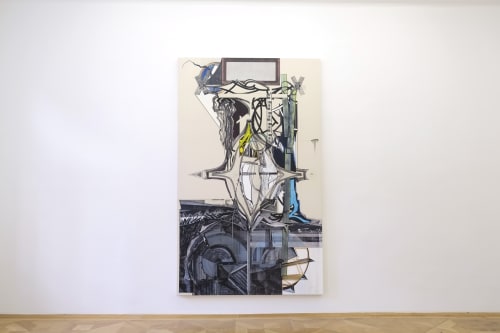Christoph Schirmer blurs several picture planes into one another, twists the axis, fans out foreshortened perspectives and slants into the picture plane - creating a spatial kaleidoscope. Similar to a picture puzzle, the individual picture planes move forwards and backwards. A clearly differentiated basic relationship between figure and background is suspended in favour of a complex camouflage. Added to this is the moment of simultaneity. Instead of a conventional ‘impressionistic’ depiction of a moment, a situation, a dazzling sample.
Elementary structures of 3D architectural graphics programmes or those of highly developed computer games flow into the works. Graphic realisations of vector graphics can be found in many pictures. Here, for example, the programme constructs a figure from individual vectors that form a skeleton without skin in order to measure shapes. This provides the artist with a graphic counterpart to his painterly, colouristic abstract image backgrounds, which are combined with them in their transparency. Another useful tool is the zoom function on the computer, which leads to radical leaps in scale in the painted picture and to a coarser and more abstract reproduction of the motif. The viewer also experiences this phenomenon when standing in front of the picture and scanning the individual segments of the painting at close range. Even from a distance, the flood of images overwhelms you. The eyes frantically change focus.
Recently, Schirmer has increasingly used a graphic network that is primarily defined by the contrast between light and dark - black lines on a white background. The garish colour palette takes a back seat. Geometric shapes mutate into intricate, multi-layered ornaments, which can occasionally be reminiscent of stained glass windows. On the other hand, they mutate into sign systems, repeatable modules that cannot be clearly deciphered. The geometric folds transform the panel painting into an interface between factual flatness and optically illusionistic depth. The grid, which was used in modernism as an important vehicle of abstraction - from Mondrian to Agnes Martin - is experiencing a postmodern, spacey-ornamental revival in Schirmer's work: a sample of Klimtian décor and minimalist hard edge. Despite the focus on the graphic matrix, an extra-painterly colour scale that reminds us of science fiction films is also decisive in the current pictures: Darth Vader's whirring laser sword in Star Wars or the glowing, vibrating tracks made by the futuristic motorbikes in Tron. Schirmer is an enthusiastic mountain biker: aspects of speed and MTB design also find their way into his visual world. The static, clear image of reality gives way to a grid broken by speed.
Excerpt from a text by Florian Steininger, curator, Bank Austria Kunstforum, Vienna


